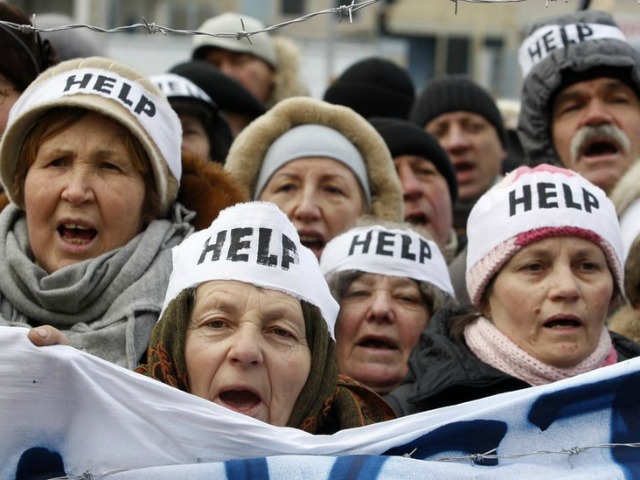
European and Americanmedia may be celebrating the triumph of the Ukraine “people’s revolution,” but the real question is who is going to payfor the $29 billion a year bailout to keep the country from goingbankrupt.
United States Secretary ofState John Kerry recognized the rebel government and pledged $1 billion ofsupport. The 28 nation European Union(EU) offered to join with the International Monetary Fund (IMF) in an aidpackage worth as much as $27 billion over seven years. But with the EU economy shrinking by a ½% overthe last five years and many member nations needing financial assistance, the bulkof the cash for a Ukrainian bailout would have to come from the U.S. Given America’s foreign economic assistance budgetis only $31.2 billion, are Americans willing or able to pay $29 billion a yearto keep the Ukraine afloat?
The U.S. is the world’s largest “bilateral” donor nation. American annual foreign aid budget is $54.5 billion, with $31.2 billionin economic assistance and $23.3 billion in military assistance. American economic assistance went to183 countries. Afghanistan was thelargest recipient at $3.3 billion; Brunei was the lowest recipient at $3,950.
Foreign aid is not popular with the American people, andthere are misconceptions about the size and effectiveness of the spending. According to a Kaiser Foundation poll,budget is spent on foreign aid, when it is about 1 percent. Further, four in ten think a major part ofU.S. foreign aid is given directly to developing countries to use as they seefit.” Only 22% of Americans believethat promoting democracy in other countries should be a top federal priority.
Three months of political upheaval exacerbated Ukraine’sweak economy and drained its foreign currency reserves. Their monthly import bill for Russian naturalgas runs $1 billion, and debt service is $1.1 billion. Plus, the National Bank of Ukraine was forced tospend $1.7 billion to stabilize the currency after a 15% fall. Ukrainealso has $17 billion due in minimum debt repayments in 2014. They also failed to sell off their bonds last week in a $2 billion offering. Ukraine’s foreign currency reserves droppedfrom $20.4 billion to $17.8 billion in January. The nation only has enough cash to pay for importsthrough April, and rumors are swirling government salaries and pensions won’t bepaid.
Ukraine received the first $3 billion tranche of a $20 billion Russian bailout inDecember that included $15 billion in bond purchases and a 30% discount onnatural gas imports. But that supportwas suspended during January riots and canceled after revolution. Russia was willing to fund the Ukraine because itis the front door to invade Russia.
The Ukraine name translatesinto English as “borderland.” WesternUkrainians fought for Germany and eastern Ukrainians fought for Russia in WorldWar I and in World War II. During July and August of1943, one million Germans and two million Russians fought the largesttank battle in the history of the world at The Battle of Kursk in Ukraine, just280 miles southwest of Moscow. The Red Army was victoriousafter being willing to suffer 1,600,000 casualties compared to the German Army’s 366,000 casualties. Kursk was the Nazi’s greatest military defeatand led to the invasion of the “Fatherland.”
America is thelargest contributor to the IMF with a 17% voting share. Together with EU members they haveover 40% control. The IMF and EU conditionedtheir financial assistance offer on the Ukraine signing an agreement to enact aslew of painful financial, fiscal, and labor austerity reforms to bringthe country’s post-Soviet economy up to Western standards. Thesereforms would entail the quality of life in the Ukraine falling for five to tenyears, including lower purchasing power and surging energy costs. Yanukovichchose a Russian bailout to avoid the violent riots he expected if Ukrainesigned an IMF bailout. This caused aviolent revolution, forcing him to flee to Russia.
The new government in Kiev that toppled Yanukovich faces the same constraintsas their predecessor. Stratfor GlobalIntelligence suggests: “the onlycard Kiev can play for the moment is to emphasize the destabilizingeffects a default would have. The economic disruption caused by adefault could reignite protests in Ukraine and shatter thefragile compromise brokered by Western powers — an option the West would findunacceptable.” But a joint EU-IMFbailout of Ukraine without painful economic reforms would be politically indefensibleto many European countries that have been battling their own economic crisisand have been subject to five years of stringent austerity.
Russia announcedon February 26th “surprisemilitary drills” along their borders with Ukraine. They activated over 150,000 army, navy, airforce, and rocket forces personnel and put select combat units from the Moscowregion on high alert. Russian fighterjets began screaming along the border as commanders were ordered to “verify operational readiness” and preparefor deployment in the event of a real military conflict.
The U.S. has engaged in bilateral military programs with Ukraine since the collapse of theSoviet Union in 1992. Combined U.S.-Ukrainemilitary operations have taken place in Bosnia, Kosovo, and Iraq. Ukrainians have proven their ability to be areliable and capable peacekeeping force, but this is far from being able to challengethe Russians.
The willingness forAmericans to financially bailout a basket-case like the Ukraine comes at a verydifficult time as the budget sequestration is hacking away at federal spendingacross-the-board. Even the once untouchableDepartment of Defense announced plans on February 24th to shrink the Armyfrom the post- 9/11 high of 570,000 to a pre-World War II size of 440,000. Paying for economic and military costs in the Ukrainewould force steeper cuts at home. It maybe enjoyable for Americans to root against the Russians, but why should theU.S. pay for Ukraine’s bankruptcy?

COMMENTS
Please let us know if you're having issues with commenting.